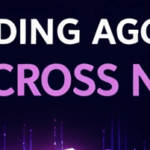In this article, I will discuss the How to Use Bridging Protocols which is a beginners guide to assist you in transferring crypto assets across various blockchains.
From navigating DeFi platforms to saving on gas fees, bridging protocols enable access. In this guide, I will discuss the basic concepts, important preliminary steps and considerations, risk factors, and safety tips for effective cross-chain asset transfers.
What Are Bridging Protocols?
Bridging protocols are blockchain technologies that allow the transfer of data or digital assets across different blockchain networks. Due to the isolated nature of most blockchains, bridging protocols help as middle technologies that promote interoperability.

They lock tokens on the source chain and issue equivalent assets on the target chain which allows users to transact on dApps and services within multiple networks. These protocols are crucial for enhancing liquidity, broaden use cases, and building a more intricate and agile decentralized ecosystem.
How to Use Bridging Protocols
Example: Bridging ETH from Arbitrum to Optimism Using Across Protocol
Step 1: Go to the Bridge Section
- Visit across.to

- Connect your wallet, for instance, MetaMask.
Step 2: Set Source and Destination
- From: Arbitrum
- To: Optimism
- Asset: ETH

- Amount: (0.5 ETH)
Across will automatically calculate the most efficient route, fees, and estimated time required.
Step 3: Approve and Bridge
- Click “Approve” to permit the bridge to access your ETH balance.
- Click “Bridge” and confirm the transaction in your wallet.
Step 4: Await Confirmation
- As per Across, the average transfer time is under 2 minutes.
- You will get notified as soon as the ETH is available on Optimism.
Why Use Bridging Protocols?
Leave Digital Silos Behind: Lets users access decentralized applications and financial services on other chains freely.
Affordability and Speed: Users can send funds to other chains that have lower gas fees or faster confirmation times.
Enhanced Token Utility: The utility of bridged tokens increases since they can be deployed across different ecosystems.
More Liquidity Supply: Helps distribute liquidity for traders, protocols, and decentralized applications from multiple chains.
How Bridging Protocols Work
Asset Locking or Burning
Original tokens are either locked in a smart contract or burned on the source blockchain.
Minting or Releasing Equivalent Tokens
An equivalent amount of tokens is minted or released on the destination blockchain.
Cross-Chain Communication
Transaction activity is securely monitored and coordinated between blockchains by validators, relayers, or oracles.
Maintaining Supply Integrity
By managing the creation and destruction of assets across networks, the bridge prevents token duplication.
Fees and Transaction Times
Gas Fees Charged by the Network: Bridging requires processes on both the originating and receiving blockchains, therefore you’ll incur gas fees for both of them. Fees differ with the level of congestion (Etheruem fees are higher than Polygon or BNB Chain).
Fee for Using the Bridge: Additional to other expenses affiliated with bridging, some platforms charge a distinctive work fee in the range of 0.1% until 1% of the total value.
Approval Fees For Tokens: In case it’s your initial sequence of bridging, you are most likely to incur an approval fee for permitting smart contract access to your funds.
Time For Transaction Completion: 1 to 30 minutes is the range for most bridges. But, validation slowness, congestion, or other security checks may create more delays on the platform.
Risks and Precautions
Smart Contract Exploits
Bridges are built upon intricate smart contracts which are prone to bugs and exploits. Even the simplest flaw can lead to significantly losing funds.
Malicious or Fake Bridges
Interacting with fake bridges can lead to lost funds. Scammers often create replicas of real bridge websites to interact with users.
Bridge Exploits and Hacks
Cross-chain systems are constantly evolving in terms of security, and several high-profile bridge hacks such as Ronin and Wormhole have led to extreme losses.
Delays and Network Congestion
Users may experience a form of congestion in the network which may in turn slow down the completion of task such as transactions.
Tips for Beginners
Small Transfers
To minimize the risk of significant losses due to errors, always begin with a small amount.
Reliable Bridges
Access only through official pages for Synapse, Multichain, or LayerZero. These are trusted platforms you can rely on.
Verify Network Selection
Before proceeding with the transfer, make sure both the source and destination chains are correct.
Look for Gas Charges
Ensure that you check service charges, gas fees, and the bare minimum transfer amount before proceeding to confirm.
Maintain Transaction Records
For resolving issues or reaching out to support, ensure you save your transaction hash (TXID).
Monitor Service Interruptions
Bridges may disable their services during times of hardware upgrades or high traffic—make sure to check status pages or community forums first.
Conclusion
Bridging protocols are instrumental in interconnecting assets within disparate blockchains as they facilitate interoperability and broaden the scope of DeFi opportunities. Users can securely move tokens between chains by knowing how to select a secure bridge, confirm network checks, and adhere to proper transaction steps.
Be it for yield farming, arbitrage, or ecosystem access, effective use of bridging protocols improves your crypto experience at all times whilst ensuring security and control.
FAQ
Do I need a specific wallet to use a bridge?
Yes, you need a Web3 wallet like MetaMask, Trust Wallet, or WalletConnect that supports the blockchains involved.
Are there fees when using a bridge?
Yes, you’ll pay gas fees on both source and destination networks, and some bridges charge service fees.








